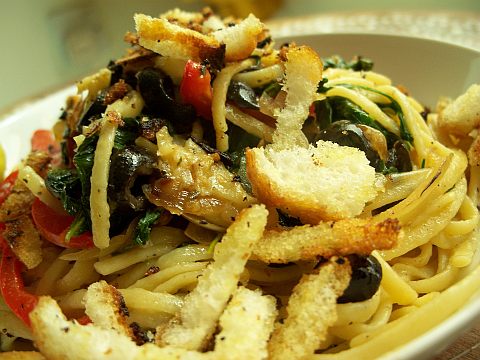
While scouring the pasta aisle at the hypermarket the other day, I came across a range of flavoured pastas. Now, these aren’t like instant ramen which are regular noodles with a flavour sachet of some kind, nor were they the usual coloured varieties of pasta (green and red, which are supposedly spinach and tomato or beetroot coloured).
This particular brand of pasta, Catelli Bistro (it’s made in Canada by Ronzoni Foods, Montreal) comes in flavours like ‘sundried tomato and basil spaghettini’ (which I’d tried before) and ‘lemon pepper linguine’ which is what I prepared today.
The recipe on the back of the pack was for a simple snow-pea and shrimp sauce, olive-oil based. I generally cook vegetarian at home. The relative lack of preparation — no marination or gutting and cleaning — and easier storage of vegetables gives me more flexibility (most meals are prepared last minute). Also my dad’s a vegetarian and I have no great craving for meat on a daily basis.
The flavours of the pasta are the main attraction here, so smothering it in a heavy tomato or cream sauce is not a good idea. I decided to stick to a light olive oil sauce and adapt it with whatever I thought might go well with lemon. To complement the tartness of lemons I went for red bell pepper (capsicum), olives, fresh basil and parsley, with onion and garlic to add crunch and sweetness.
The olives were pre-sliced stuff I got at the market. I know, I know, they’re not as nice as unpitted ones, but the last time I got some good Moroccan olives they were lovely but very salty and overpowered all other flavours (this was with the flavoured spaghettini). These cheap ones aren’t as intense so they go better with this dish.

I used one large red bell pepper, both for colour and because unlike their green and yellow cousins, these are pretty mild. I cut the pepper into strips as you can see here, to go better with the linguine. Since it’s a long, flat noodle-like pasta (but not as wide as fettucine) I kept the strips thin enough but not too thin. I wanted the vegetables to retain some crunch; if you cut them too fine they go limp.

The onion and garlic I cut up just like the peppers, long (the garlic was sliced along the length of the clove, and this turned out unexpectedly well. I’ll tell you why later).
The basil and parsley next. It’s a chore to get basil here. Parsley and coriander are readily available, as is rocket (arugula), but it’s alway hit and miss with the lemon-scented local basil. Even when it’s around you’re likely to find a half-wilted bunch, or worse, a good bunch that is all purple and nasty the very next day despite being properly stored in the fridge.
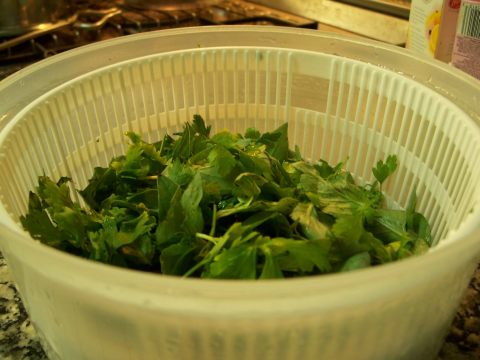
I had an unshakeable feeling in the back of my head these past few days that by the time I’d get a chance to cook at home it would be long past usable, but I lucked out this time. The bunch was not bad and despite a few wilted leaves it was actually okay. The basic rule for basil: buy it fresh, use it as soon as you can, or learn to make a lot of pesto.
The most time-consuming part of this entire recipe was picking and cleaning the basil and pasley leaves. Now, with coriander (and to a lesser extent, parsley) you can and should use the stalks as well. Good coriander stalks are sweet and crunchy like bean sprouts, and the mistake people make is to only use the leaves. You’re only getting half the flavour, a somewhat bitter, mint-like flavour that the leaves have. Chop up the stalks nice and small and watch the flavours balance out. Same goes for parsley, but sometimes the stalks can be unpalatably chewy, so make sure what you put into the dish is tender.
The local basil stalks are downright inedible, and the bunches are usually sandy (not as sandy as the rocket, which can take 20 minutes to clean properly). So, I spent a lot of time picking only the leaves of the basil, and the leaves and tender stalks of the parsley. Thankfully I have a salad spinner I got at IKEA (it’s a simple hand-crank centrifuge for your food) so cleaning and drying the leaves was a cinch. Lots of sand settled at the bottom after washing, though, so clean thoroughly. It may be wise to do this step ahead of time (when you buy the basil) and keep the leaves in an airtight bag. Still, as with all green leafy vegetables, use it quick.
I don’t think you can use Indian Holy Basil for this dish — it’s far too strong. Maybe a few leaves as a garnish, but nothing more.
One final touch: On an early episode of The Naked Chef Jamie Oliver made a spaghetti dish in a light wine, lemon and butter sauce with shrimp, and used a wicked garnish. Since this dish would be similar I employed the same garnish here.
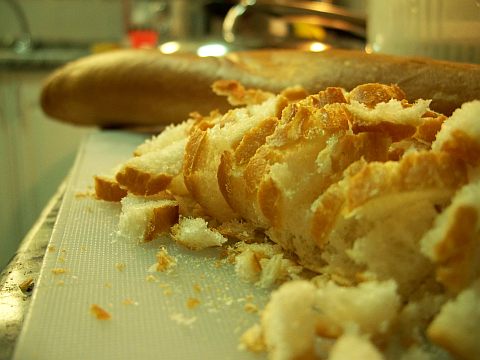
I had an old piece of baguette laying around. The good thing about old baguettes is that they don’t ever seem to spoil. The bad thing is they go rock hard and can only be used as breadcrumbs, croutons, soup sticks (if you somehow manage to cut them evenly) or in french toast. I just started slicing my bread the same thickness as the onions and peppers, pressing down on it with a regular chef’s knife (as opposed to sawing away at it with a serrated bread knife). I did this on purpose since I didn’t want clean slices. The trick paid off — with every cut the bread shattered as the knife came down. As you can see I ended up with a bunch of uneven chunks and crumbs.
Onto the cooking!
I cooked the pasta as per the instructions on the packet. The minute they hit the water a strong aroma of lemon filled the kitchen. At least the name on the box wasn’t just for show (unlike some red and green pastas I’ve had).
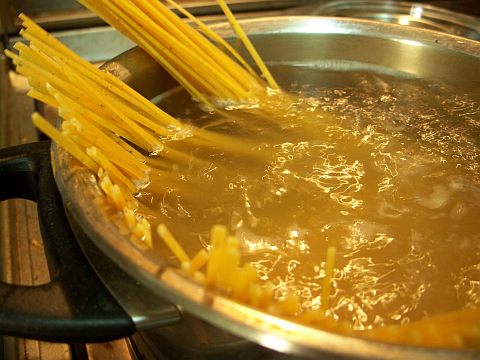
Once done, put them aside with a little olive oil to keep them loose. When I was growing up every pasta cooking lesson (even from TV chefs) was the same: boil water, add salt and oil, cook until al dente, then drain in a colander and rinse with cold water. Nowadays everyone seems to have done an about face, and from my experience the pasta tastes better.
So, the only thing that goes into the water should be salt, the heat should always be high and the water briskly boiling (except for the minute or so when you first put in the pasta, when you should stir continuously until it comes back to a boil so that nothing clumps up), and before you drain it keep a cupful of the water aside for later.
Once you do drain it don’t put any water on it, cold or otherwise. Transfer it straightaway to a covered bowl or pot and put some olive oil into it to keep it loose.
You shouldn’t keep the pasta for too long, as any pasta will get dry and clump up a bit and need to be loosened later (this is why the cup of pasta water was kept aside). You can time it so that the sauce is ready just as the pasta is. It usually takes 20 minutes from a cold pot of water to finished pasta, which, if you’re ready with all the ingredients, is more than enough time to make the sauce.
First, into a cold pan, put in a bit of olive oil and half the garlic. Get the heat up to high, by which time the garlic will have started frying well. Add the bread in and stir it around. You can put in dry herbs like oregano or thyme here. They help. Fry the bread until golden brown.
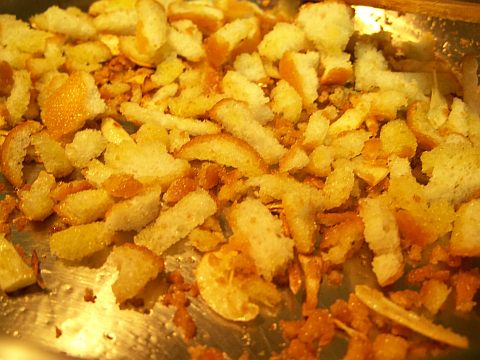
Remember what I said earlier about cutting the garlic long? The slices not only fried, after the bread was added in and it soaked up the olive oil the garlic also roasted and went all sweet and crackly, which I loved.
Unfortunately a total meltdown in timing occurred, and my pasta was overcooked while I kept watch on the bread. By the time I’d drained it and kept it aside the breadcrumbs had burnt. They weren’t charred so it was still usable. The lesson is that you should keep an eye on things or they can get out of hand very quickly.
Keep the fried bread aside (don’t cover it or it may go soft) and after cleaning away most of the stray breadcrumbs return the pan to the fire. Add in a good amount of olive oil. This will form the base of your sauce and has to further coat the noodles, but I’ll leave the definition of how much a ‘good amount’ is to you. Experiment and see what you like. You can always drizzle a little more over the top at serving time.
The actual sauce is simplicity itself. When the oil is hot put in the onions and the rest of the garlic, then fry them on medium-high heat until they’re cooked to your liking (I kept everything a little crunchy so the onion wasn’t browned before adding the rest of the ingredients). The garlic you add here won’t crackle like the one in the garnish, and adds a softer garlic flavour to the oil/sauce.
Put in the pepper and the olives, and toss.

You can chop up the basil and parsley, but I chose to keep the leaves and sprigs whole (not many stalks, so nothing to chop). Toss these in and they’ll start to wilt. You can add salt and pepper here.

I don’t cook the leaves too much. They should still have some crunch left in them. Add in the pasta and toss again. You probably will have to put in some of the pasta water here to unclump it and give a little liquid to the sauce.
Toss until it’s all well mixed up, then put some in a bowl, sprinkle a good handful of the garnish on top, some grated Parmesan cheese, and serve with a wedge of lime or lemon on the side.
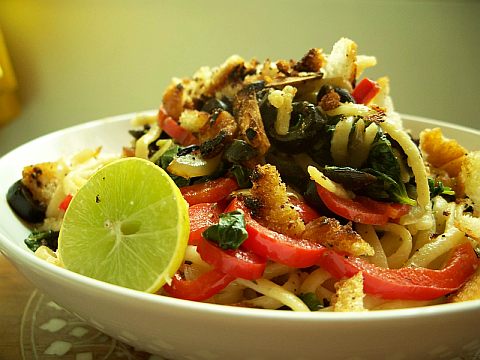
(click on this image for a 1600×1200 wallpaper)
The fresh lime juice, I find, adds that final touch to the sauce. All in all it tasted good. The flavour of the linguine itself is lemony and peppery, though it’s not as strong as the aroma I got when it went into the water. This stuff definitely will not work with a heavy sauce.
The sauce itself was tasty; the ingredients worked well together and I didn’t have to use as much oil as I thought I would (a quarter cup is fine, though some extra goes into the fried bread). The fried bread topping is fantastic enough to be considered more than just a garnish, and the smoky flavours are a perfect counterpoint to the fresh, zesty and tart taste of the rest of the dish.
A couple of weeks ago, as I mentioned earlier, I had also tried their flavoured spaghettini (basil and sundried tomato, which was served in a sauce of Moroccan olives and green beans) and was generally impressed by it. The flavours weren’t by any means overwhelming but they were significant enough to warrant the extra price, once in a while.
It should be noted, however, that the flavoured pastas aren’t a substitute for actual sundried tomatoes, basil and lemon.
In fact, if you’re using regular pasta, I would suggest getting some (unwaxed) lemons and slicing them fine or zesting them and adding that and the lemon’s juice into the sauce. It should make a fine enough — and probably superior — alternative to this dish. You can also use other kinds of pastas. Fusilli and penne will also work, just dice the vegetables instead of cutting into strips.
You can serve the pasta as a side to grilled fish or other meats. You could even turn the whole thing into a warm salad by reducing the amount of pasta and not adding the parsley and basil to the sauce. Put it in a bowl with assorted salad leaves (or rocket) and pour the hot pepper and olive sauce/dressing and the fried bread over it.
Either way, mission accomplished!











